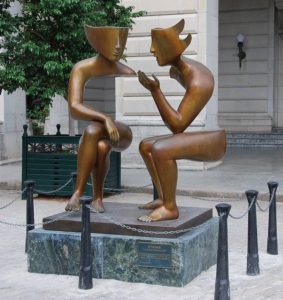
The Dream That Was a Test
Parshat Vayetzei is a parsha of galut, a parsha where we can feel the familiar stresses of exile. The structure of the parsha reflects this theme. It begins with the words “And Yaacov left” and then continues, like a run-on sentence, with no parashah petuhah or parashah setumah (spaces in the Torah text), until the very end. In this parsha, there is no place to find rest, or peace of mind. Yaacov is uprooted from his physical home and his spiritual source. The Zohar compares his journey to one who is descending into a very deep well. However, this parsha is not just the story of Yaacov experiencing galut. It is also the story of Yaacov triumphing over galut. Even more, this parsha gives us insight into ourselves, and the tools that Yaacov left us, so that we, too, can triumph over whatever form of galut we happen to be in.
The parsha begins, “And Yaacov left from Be’er Sheva.” In a play on words, Bereisheit Rabbah (68:7) tells us that Yaacov left from the Well of Oaths. A person about to go down into a very deep well would do well to tie himself to a very strong rope that will lead him back to the top. That rope, for Yaacov, was an oath. Specifically, says the midrash, it was an oath of seven.
What was this oath of seven? This number seven refers to the seven lower middot. Without attempting to give any real explanation of the kabbalistic concept, we can understand the seven lower middot as seven essential strengths of our soul. As we have discussed before, each of our Avot had a unique way in which they were meant to serve Hashem, and each of the Avot was tested in that exact area. Yaacov’s middah was the middah of Emet, truth. The nature of truth is that it does not change. It is always true. Yaacov’s test, as he went into a world of deceit, a world where he would be forced to use cunning to survive, was whether he could remain unchangingly true to his own spiritual self. To strengthen himself, before he left, Yaacov took an oath, a vow to tie each one of his strengths to his higher self. Although he would use many different strengths to survive in galut, Yaacov vowed to live only in accordance with the truth of who he was in his deepest self.
Rav Schorr explains that this vow was immediately put to the test. Yaacov was tested through sleep, which is often used by Chazal as a metaphor for galut. On a purely physical level, sleep is a time when our control over ourselves is not strong. In our sleep we are unguarded, and are therefore more likely to reveal the essence of who we are. Yaacov was tested to see if even in a state of sleep, and a state of galut, he would remain unchangingly true to his spiritual self.
Yaacov’s dream begins with “v’hinei, and there was,” a word which introduces a new idea, a chiddush. In this case, that chiddush was a ladder, which was used as a symbol for the natural world. The natural world is completely rooted in the physical, and yet, it reaches up to the heavens. Through deep contemplation of nature, we come to deep recognition of Hashem. The ladder in Yaacov’s dream represented a beautiful spiritual path of living in harmony with the world and the laws of nature, and also in continuous connection to Hashem. The question posed in the dream was, will Yaacov attach himself to this level of spirituality?
At first glance we might be tempted to think that that is exactly what Yaacov was meant to do. Sure, this natural level wasn’t the level of Yaacov as we described him in last week’s essay. However, things have changed since the time when Yaacov spent all day in his tent. Looking at this moment in Yaacov’s life, we see so much destruction. The Midrash Tanchuma compares Yaacov’s exile to the exile of a person who murdered someone accidentally. Through Yaacov’s actions, Eisav was cut off from his rightful spiritual inheritance, his eternal life. Yaacov cannot walk away from that reality easily. As he enters galut, he is facing an uncertain future, where the original plan, of Eisav and Yaacov working together to continue Avraham’s legacy, is no longer in play.
This is reflected in how Yaacov perceives the first stop on his journey. The pasuk says, “vayifga bamakom,” he encountered a place, or as Rav Hirsch explains it, he was struck by a place, and that place impacted him. That “place” was Har HaMoriah, but the midrash says that what Yaacov saw there was the Beit Hamikdash in ruins. Har HaMoriah was built up through the akeidah. When Avraham first sees it, from afar, it is just a place: “he saw the place from afar (Bereisheit 22:4).” However, by the end of the akeidah, Avraham has given the place a name, and the Torah has changed its description from “place” to “mountain.” It is now the “mountain of Hashem Yira’eh (22:14).” The Midrash says that Avraham built a mountain from the valley, but that is not how Yaacov experiences it. He sees just “a place.” Avraham’s legacy appears diminished.
Despite all of this, despite the galut, despite his own limitations, despite the undisputed fact that he is leaving the land of miracles, Yaacov refuses to settle for a natural path of spirituality. He knows himself, he knows his soul, and he knows that this path is not fitting for him. Even in his sleep, Yaacov refuses to attach himself to it.
And so, the dream begins again. Once again, we see the word, “v’hinei,” indicating a new aspect being revealed. Now, Yaacov sees angels going up and down the ladder. This expresses a higher level of revealed spirituality, a closer connection to Hashem. This is a level of connection to Hashem beyond nature, through the means of angels. Yaacov rejects this level as well. This is still not the level of his soul.
Finally, for a third time, the nevuah begins again. And this time, Hashem Himself is standing over Yaacov. This is the direct connection to Hashem that Yaacov was seeking, a level of guidance completely beyond the order of nature. This is the only level which is true to Yaacov’s spiritual level, the level that he finally accepts.
Rav Schorr tells us that it is not just that this was the only level that was fitting for Yaacov. This is the real level of all of us, children of Yaacov. This level is implanted spiritually within us. We may be deep in the well of galut, but that doesn’t mean we have to let go of our grip on our rope. We are not supposed to lose sight, even in galut, of who we really are, and what we are able to accomplish spiritually.
True, we are not all on the level of Yaacov Avinu. Hashem may not stand above each of us in our dreams. But we all have the ability to create a relationship with Hashem. We can open up our mouths and talk to Hashem at any moment, even if we are not that religious, not that spiritual, or don’t feel ourselves to be that great. Our circumstances, even if they are not what we want them to be, are not a reason to ever lose touch with that relationship. We have neither the requirement to, nor permission to, accept a subpar level of spirituality.
Yaacov Avinu did not let any of the circumstances of his life, neither his external stresses, nor his own limitations, interfere with his relationship with Hashem. This is a middah which the Sfat Emet called the Middah of Hishtavut, and it is the ability to meet all of life’s challenges with equanimity, due to an unswerving commitment to, and faith in, our relationship with Hashem. I would like to end with a story, which I feel illustrates this middah of commitment to relationship with Hashem in the face of even the greatest challenges, in a very inspiring and down to earth way. It comes from Yair Rosenberg’s 2013 interview of Rabbi Jonathan Sacks.
Though he seldom mentions it, Sacks battled cancer twice, once in his 30s, and later in his 50s. Yet unlike many other rabbis and scholars of religion, from Rabbi David Wolpe to James Kugel, who incorporated their bouts with cancer into their theological reflections, Sacks makes no reference to it in his voluminous output. I asked why.
“It’s very simple,” he said. “I saw my late father in his 80s go through four, five major operations. This was not cancer, it was hip replacements and those things. And when you have operations in your 80s, they sap your strength. He got weaker and weaker as the decade passed. He was walking on crutches at my induction—he was alive for my induction, and that was very important to me.”
“Now, my late father, alav ha-shalom, didn’t have much Jewish education, but he had enormous emunah [faith],” Sacks continued. “I used to watch him saying Tehillim in the hospital, and I could see him getting stronger. It seemed to me that his mental attitude was ‘I’m leaving this to Hashem. If he sees that it’s time for me to go, then it’s time for me to go. And if he still needs me to do things here, he’ll look after me.’”
“And I adopted exactly that attitude. So on both occasions I felt, if this is the time Hashem needs me up there, thank you very much indeed for my time down here; I’ve enjoyed every day and feel very blessed. And if he wants me to stay and there’s still work for me to do, then he is going to be part of the refu’ah [healing] and I put my trust in him. So there was no test of faith at any point—just these simple moments at which to say, ‘b’yado afkid ruchi’ [‘In his hand, I place my soul’]. That was my thought. And since we say that every day in [the prayer] Adon Olam, I didn’t feel the need to write a book about it. It was for me not a theological dilemma at all.”
“I had faith,” said Sacks, “full stop.”
This Shabbat marks the second year Yahrzeit of my beloved father-in-law, Albert Allen a”h. He was a man who truly understood the value of relationships, and those of us who had the pleasure of knowing him miss him very much.
לעילוי נשמת אברהם בן סלחא ע”ה



